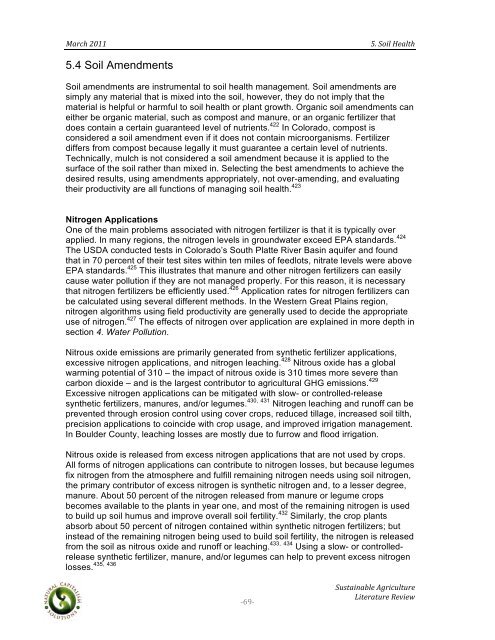Sustainable Agriculture Literature Review - Boulder County
Sustainable Agriculture Literature Review - Boulder County
Sustainable Agriculture Literature Review - Boulder County
Create successful ePaper yourself
Turn your PDF publications into a flip-book with our unique Google optimized e-Paper software.
! !!<br />
"#$%&!'())!! !!!!!!!!!!!!!!!!!!!!!!!!!!!!!!!!!!!!!!!!!!!!!!!!!!!!!!!!!!!!!!!!!!!!!!!!!*+!,-./!01#/2&!<br />
5.4 Soil Amendments<br />
Soil amendments are instrumental to soil health management. Soil amendments are<br />
simply any material that is mixed into the soil, however, they do not imply that the<br />
material is helpful or harmful to soil health or plant growth. Organic soil amendments can<br />
either be organic material, such as compost and manure, or an organic fertilizer that<br />
does contain a certain guaranteed level of nutrients. 422 In Colorado, compost is<br />
considered a soil amendment even if it does not contain microorganisms. Fertilizer<br />
differs from compost because legally it must guarantee a certain level of nutrients.<br />
Technically, mulch is not considered a soil amendment because it is applied to the<br />
surface of the soil rather than mixed in. Selecting the best amendments to achieve the<br />
desired results, using amendments appropriately, not over-amending, and evaluating<br />
their productivity are all functions of managing soil health. 423<br />
Nitrogen Applications<br />
One of the main problems associated with nitrogen fertilizer is that it is typically over<br />
applied. In many regions, the nitrogen levels in groundwater exceed EPA standards. 424<br />
The USDA conducted tests in Colorado’s South Platte River Basin aquifer and found<br />
that in 70 percent of their test sites within ten miles of feedlots, nitrate levels were above<br />
EPA standards. 425 This illustrates that manure and other nitrogen fertilizers can easily<br />
cause water pollution if they are not managed properly. For this reason, it is necessary<br />
that nitrogen fertilizers be efficiently used. 426 Application rates for nitrogen fertilizers can<br />
be calculated using several different methods. In the Western Great Plains region,<br />
nitrogen algorithms using field productivity are generally used to decide the appropriate<br />
use of nitrogen. 427 The effects of nitrogen over application are explained in more depth in<br />
section 4. Water Pollution.<br />
Nitrous oxide emissions are primarily generated from synthetic fertilizer applications,<br />
excessive nitrogen applications, and nitrogen leaching. 428 Nitrous oxide has a global<br />
warming potential of 310 – the impact of nitrous oxide is 310 times more severe than<br />
carbon dioxide – and is the largest contributor to agricultural GHG emissions. 429<br />
Excessive nitrogen applications can be mitigated with slow- or controlled-release<br />
synthetic fertilizers, manures, and/or legumes. 430, 431 Nitrogen leaching and runoff can be<br />
prevented through erosion control using cover crops, reduced tillage, increased soil tilth,<br />
precision applications to coincide with crop usage, and improved irrigation management.<br />
In <strong>Boulder</strong> <strong>County</strong>, leaching losses are mostly due to furrow and flood irrigation.<br />
Nitrous oxide is released from excess nitrogen applications that are not used by crops.<br />
All forms of nitrogen applications can contribute to nitrogen losses, but because legumes<br />
fix nitrogen from the atmosphere and fulfill remaining nitrogen needs using soil nitrogen,<br />
the primary contributor of excess nitrogen is synthetic nitrogen and, to a lesser degree,<br />
manure. About 50 percent of the nitrogen released from manure or legume crops<br />
becomes available to the plants in year one, and most of the remaining nitrogen is used<br />
to build up soil humus and improve overall soil fertility. 432 Similarly, the crop plants<br />
absorb about 50 percent of nitrogen contained within synthetic nitrogen fertilizers; but<br />
instead of the remaining nitrogen being used to build soil fertility, the nitrogen is released<br />
from the soil as nitrous oxide and runoff or leaching. 433, 434 Using a slow- or controlledrelease<br />
synthetic fertilizer, manure, and/or legumes can help to prevent excess nitrogen<br />
435, 436<br />
losses.<br />
!<br />
"%$"<br />
!,342#.5#6/1!78$.%3/23$1!<br />
9.21$#23$1!:1;.1
















